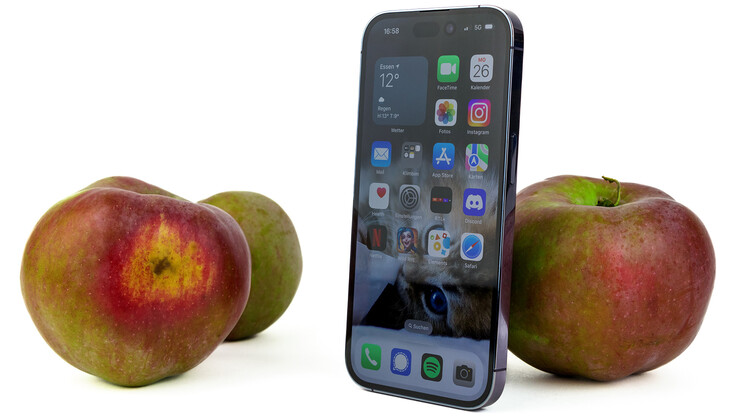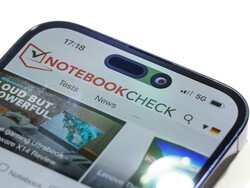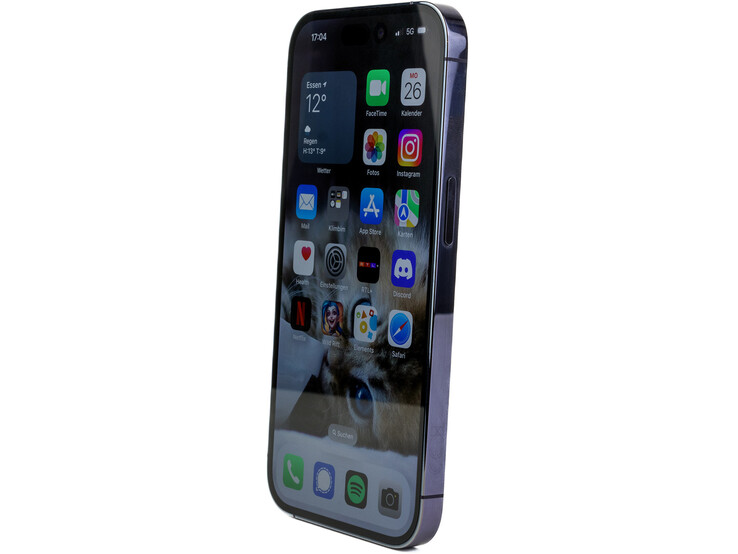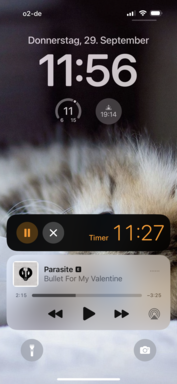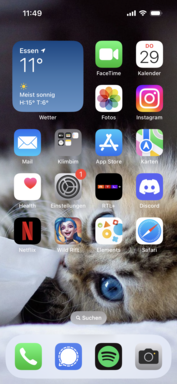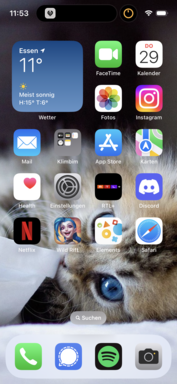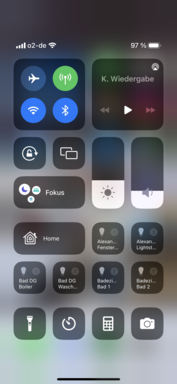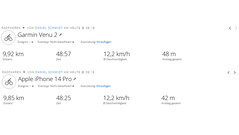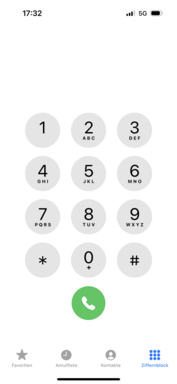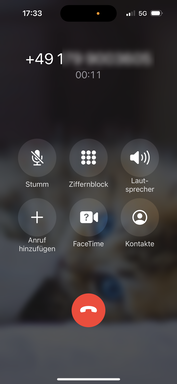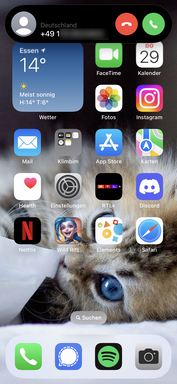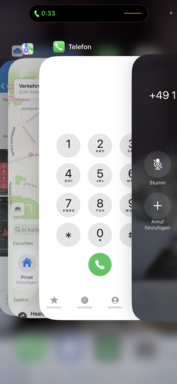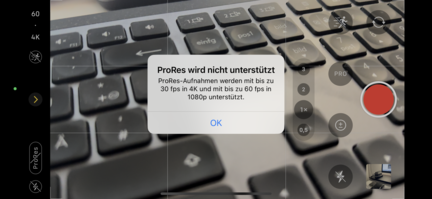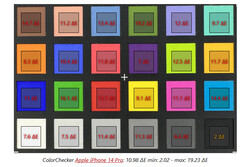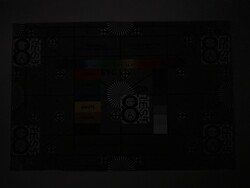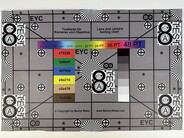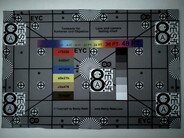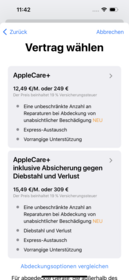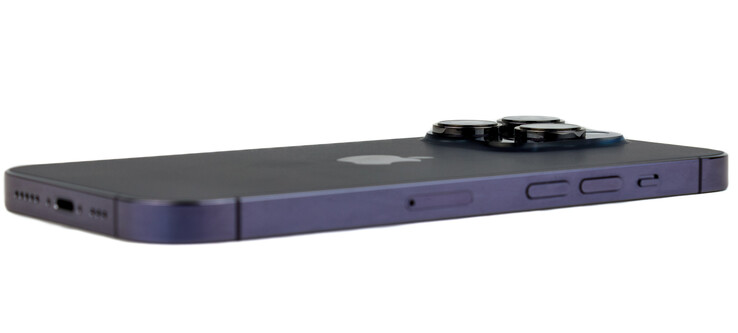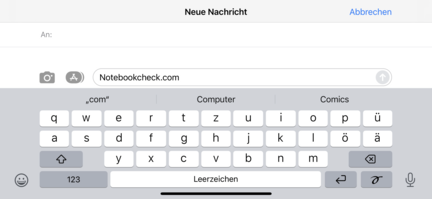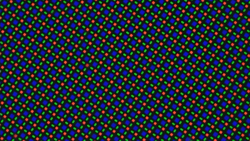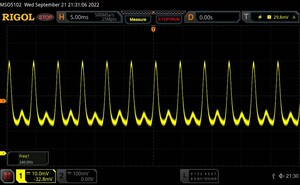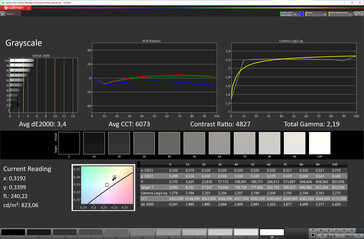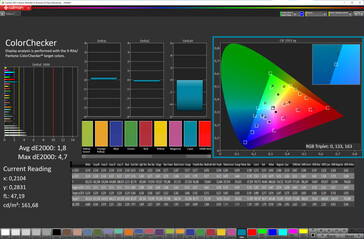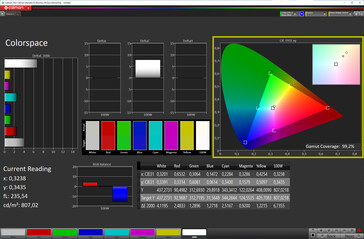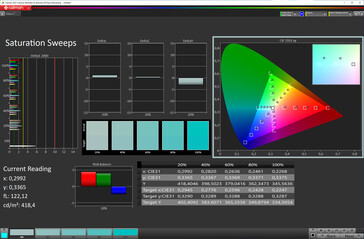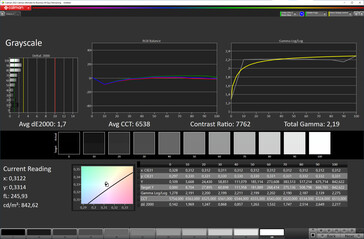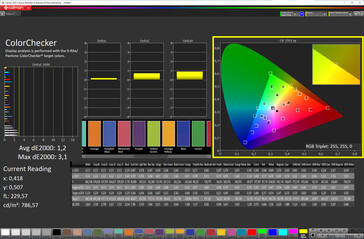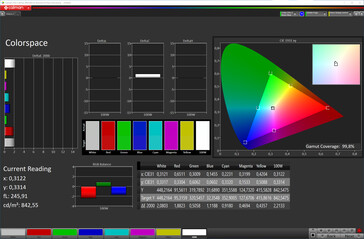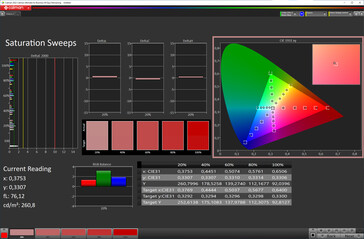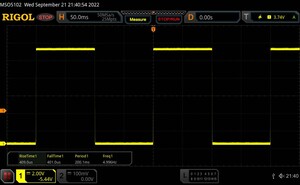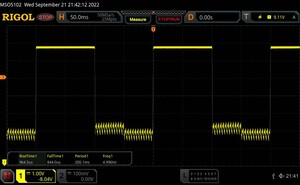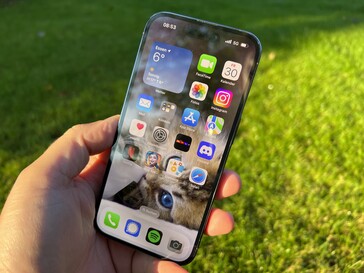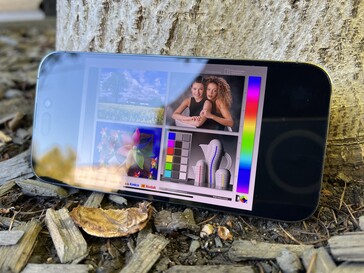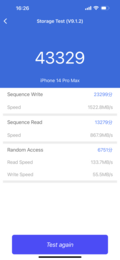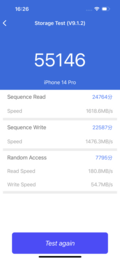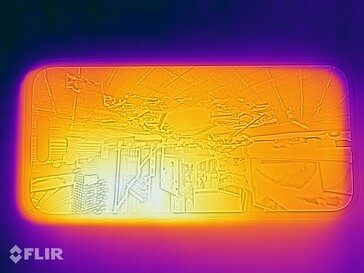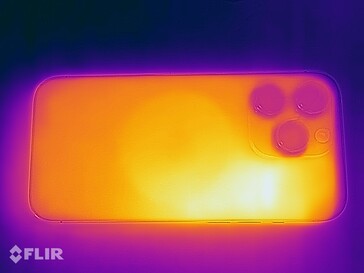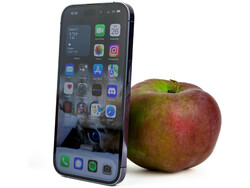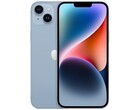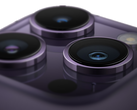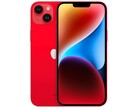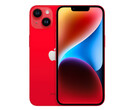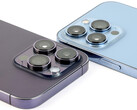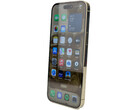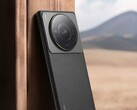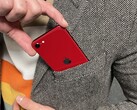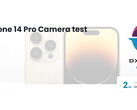Apple iPhone 14 Pro review - Dynamic Island stands out on the Apple smartphone ↺
The iPhone enters the next round with this year's iPhone 14 Pro succeeding last year's iPhone 13 Pro. As with each new generation, Apple uses a new SoC, improved cameras, and the latest iOS version while retaining the same form factor once again this time around. The camera upgrades are particularly interesting this year, since the Cupertino-giant is using a 48 MP main sensor and pixel-binning technology for the first time.
As the following table details, the prices have increased significantly this year:
| Storage | iPhone 14 Pro (Germany) | iPhone 13 Pro (Germany) | iPhone 14 Pro (US, pre-tax) |
|---|---|---|---|
| 128 GB | 1,299 Euros (+ 13.05 %) | 1,149 Euros | 999 US Dollar |
| 256 GB | 1,429 Euros (+ 12.61 %) | 1,269 Euros | 1,099 US Dollar |
| 512 GB | 1,689 Euros (+ 12.68 %) | 1,499 Euros | 1,299 US Dollar |
| 1024 GB | 1,949 Euros (+ 12.72 %) | 1,729 Euros | 1,499 US Dollar |
As we will see later on in the review, videography fans will unfortunately have to skip the smallest storage option.
Potential Competitors in Comparison
Rating | Date | Model | Weight | Drive | Size | Resolution | Price |
|---|---|---|---|---|---|---|---|
| 90.3 % v7 (old) | 01 / 2023 | Apple iPhone 14 Pro A16, A16 GPU 5-Core | 206 g | 256 GB NVMe | 6.10" | 2556x1179 | |
| 89.4 % v7 (old) | 03 / 2022 | Samsung Galaxy S22 Ultra 5G Exynos 2200, Xclipse 920 | 228 g | 128 GB UFS 3.1 Flash | 6.80" | 3088x1440 | |
| 89.2 % v7 (old) | 04 / 2022 | Oppo Find X5 Pro SD 8 Gen 1, Adreno 730 | 221 g | 256 GB UFS 3.1 Flash | 6.70" | 3216x1440 | |
| 89.3 % v7 (old) | 10 / 2022 | Motorola Edge 30 Ultra SD 8+ Gen 1, Adreno 730 | 198.5 g | 256 GB UFS 3.1 Flash | 6.67" | 2400x1080 | |
| 88.8 % v7 (old) | 09 / 2022 | Xiaomi 12S Ultra SD 8+ Gen 1, Adreno 730 | 225 g | 256 GB UFS 3.1 Flash | 6.73" | 3200x1440 | |
| 87.7 % v7 (old) | 08 / 2022 | Sony Xperia 1 IV SD 8 Gen 1, Adreno 730 | 185 g | 256 GB UFS 3.1 Flash | 6.50" | 3840x1644 | |
| 88.6 % v7 (old) | 07 / 2022 | Honor Magic4 Pro SD 8 Gen 1, Adreno 730 | 215 g | 256 GB UFS 3.1 Flash | 6.81" | 2848x1312 | |
| 88.5 % v7 (old) | 09 / 2022 | Vivo X80 Pro SD 8 Gen 1, Adreno 730 | 215 g | 256 GB UFS 3.1 Flash | 6.78" | 3200x1440 |
Case: iPhone 14 Pro now without a Notch
The iPhone 14 Pro comes in four different colors: Space Black, Silver, Gold, and Deep Purple. The cameras on the back now protrude even further from the case at 4.15 mm (~0.16 in). On the iPhone 13 Pro, the bump was slightly smaller at 3.75 mm (~0.15 in). This results in the smartphone wobbling around quite a bit when set down on a table or other flat surfaces. With 3 g more, the new iPhone is also slightly heavier.
The build quality and the materials of the iPhone 14 Pro are outstanding. The clearances are extremely tight and even. While the smartphone is also very resistant to twisting attempts from the corners, there was some creaking from the inside. Both the front and the back consist of glass with the latter being matte. Although this results in great haptics and optics, it also turns the phone into a fingerprint magnet. Fingerprints quickly and visibly accumulate even on the matte back. The same holds true for the polished, high-gloss stainless steel frame.
The notch is now dead — long live the Dynamic Island. It consists of not one but two hole-punch interruptions in the display that contain the front camera, Face ID, and other sensors. The software visually combines both areas into one, creating the Dynamic Island. When the display becomes very bright, the contrast drops and the edges become visible — speaking of which they are fairly wide, particularly when compared to other manufacturers' solutions.
The physical buttons seem to be of high quality and they are attached firmly. Travel is not too shallow but crisp and precise. The SIM slot, which is still included on our European model, sits flush within the frame. The internal sim tray consists of metal and is able to hold one nano SIM card. The iPhone 14 Pro continues to feature an IP68 certification, signifying dust and water protection. According to Apple, the latter is guaranteed up to a depth of six meters (~20 ft) and for up to 30 minutes.
In terms of maintainability, our colleagues over at iFixit gave the iPhone 14 one of the best scores in a long time (7/10). They were pleased with the complete internal overhaul of the smartphone and the resulting longevity and environmental benefits. This does not apply to the Max model, however. A full product environmental report is available on Apple's official web page.
Connectivity: Still no USB for the iPhone
The Apple iPhone 14 Pro continues to rely on the Lightning connector for wired data transfers and charging. Since the transfer rates correspond to the USB 2.0 standard, large file transfers and local backups take up more time. Video and audio adapters can be connected to the smartphone via optional accessories.
Users who like taking videos with their iPhone should skip the smallest storage variant. The video quality of the 128 GB model is limited to Full HD at up to 30 fps when ProRes is enabled. On the 256 GB models and above, the mode also supports up to 60 fps or Ultra HD at up to 30 fps. Thankfully, at least the Cinema Mode comes without any restrictions.
Bluetooth 5.3, NFC, UWB, and MagSafe are supported. MagSafe refers to a magnet on the back of the smartphone used to attach accessories and charging docks.
Software: iOS 16, Dynamic Island, and Always-on display
The Apple iPhone 14 Pro comes with iOS 16 and has already received two updates containing bug fixes, which take our iOS version at the time of testing to 16.0.2. The new operating system is expected to become available for all models down to the iPhone 8 and 8 Plus, making all iPhones released within the last five years up to date. Since certain features rely on new hardware, not all new features will be available on the older models. Although there has not been any official statement from Apple, users can most likely expect similar update support for the iPhone 14 Pro down the line.
While there have been no major design changes to iOS, the lock screen is now more customizable. For example, live activities allow users to display ongoing events without having to unlock the iPhone. The functionality of widgets and the focus mode has also been expanded. The dictation feature now automatically inserts punctuation and allows for the use of emojis. The home app has been completely revamped and now supports the smart home standard "Matter".
The Dynamic Island is a new software solution designed to mask the punch holes in the front display and present information of currently active apps in a space-efficient manner. This works well during use and is very practical. While the feature is still mostly limited to Apple's own apps at the time of writing, other app developers are also able to access the interface. The iPhone now features an always-on display, which can be customized to your liking. Although this is not exactly a groundbreaking new feature, it is practical and its implementation is excellent.
A detailed overview of all the new features of iOS 16 is available directly from Apple. When the Dynamic Island is not active, the interruptions in the display from the camera holes are hidden.
Communication and GNSS: iPhone 14 Pro without Wi-Fi 6E
The Qualcomm Snapdragon X65 5G Modem-RF System ensures an optimal mobile connection with a very wide range of supported frequency bands and transfer rates of up to 10 Gb/s. 5G mmWave is supported exclusively by the US models — the same holds true for the emergency call feature via satellite. The crash detection feature is available on all models and is able to call emergency services if and when it recognizes dangerous situations, although this does not appear to work flawlessly under all circumstances.
The Wi-Fi module is not quite up to the latest standards, since it does not support Wi-Fi 6E and the associated 6 GHz band. In addition, the transfer rates within the 5 GHz network of our Asus ROG Rapture GT-AXE11000 reference router are somewhat slow, but at least consistent in both directions.
| Networking | |
| Apple iPhone 14 Pro | |
| iperf3 receive AXE11000 | |
| iperf3 transmit AXE11000 | |
| Samsung Galaxy S22 Ultra 5G | |
| iperf3 receive AXE11000 | |
| iperf3 transmit AXE11000 | |
| iperf3 transmit AXE11000 6GHz | |
| iperf3 receive AXE11000 6GHz | |
| Oppo Find X5 Pro | |
| iperf3 receive AXE11000 | |
| iperf3 transmit AXE11000 | |
| Motorola Edge 30 Ultra | |
| iperf3 receive AXE11000 | |
| iperf3 transmit AXE11000 | |
| iperf3 transmit AXE11000 6GHz | |
| iperf3 receive AXE11000 6GHz | |
| Xiaomi 12S Ultra | |
| iperf3 receive AXE11000 | |
| iperf3 transmit AXE11000 | |
| Sony Xperia 1 IV | |
| iperf3 receive AXE11000 | |
| iperf3 transmit AXE11000 | |
| iperf3 transmit AXE11000 6GHz | |
| iperf3 receive AXE11000 6GHz | |
| Honor Magic4 Pro | |
| iperf3 receive AXE11000 | |
| iperf3 transmit AXE11000 | |
| Vivo X80 Pro | |
| iperf3 receive AXE11000 | |
| iperf3 transmit AXE11000 | |
| Apple iPhone 13 Pro | |
| iperf3 transmit AX12 | |
| iperf3 receive AX12 | |
| Average of class Smartphone | |
| iperf3 receive AXE11000 | |
| iperf3 transmit AXE11000 | |
| iperf3 transmit AXE11000 6GHz | |
| iperf3 receive AXE11000 6GHz | |
The device uses dual-band GNSS for geolocation and supports the satellite networks GPS, Glonass, Galileo, BeiDou, and QZSS. During day-to-day use, the satellite uplink is quickly established and relatively precise even in buildings.
In order to take a closer look at the precision of the locating capabilities, we take the iPhone 14 Pro with us on a bike ride. Here, it competes against the Garmin Venu 2. The total recorded distance is 70 m shorter on the Apple smartphone, and the detailed progression shows that the iPhone requests position updates less frequently than the smartwatch. Still, the route is recorded quite accurately overall.
Telephony and call quality
The call quality of the Apple iPhone 14 Pro when put up against the user's ear is excellent in quiet environments and voices sound very natural. When ambient noise, such as the voices of people in the background is introduced, they are audible for your conversational partner for a short period of time and subsequently filtered out. Near main roads, this process takes significantly longer, noise fragments can still occasionally permeate the conversation, and the voice of the user can become distorted.
Since ambient noise is not filtered by the iPhone while on speakerphone, this mode should ideally be reserved for quiet environments. While our voice sounds duller in this case compared to when the phone is held up to your ear, it still sounds fairly natural despite some small disturbances which made their way into our sample calls, particularly when the smartphone was very close to the user. The range of the microphone is good and captures our voice at almost the same volume from 2 m (~6.56 ft) away.
The iPhone supports VoLTE and Wi-Fi calling. Our test device accepts a nano SIM card. Additionally, or alternatively, there is an integrated eSIM. Devices sold in the US no longer come with a physical SIM slot and instead offer dual eSIM support.
Cameras: 48 MP and sensor-shift OIS
A lot has changed in terms of the cameras with the iPhone 14 Pro. The front camera sensor still has a resolution of 12 MP but now features a nominally more light-sensitive f/1.9 aperture and autofocus. This results in good selfies even in low-light situations. The front shooter even supports RAW capturing and goes all out when it comes to video recording. Videos can be captured at up to Dolby Vision Ultra HD with up to 60 fps, in ProRes (4K @30 FPS, 1080p @60 FPS), or using the cinema mode.
Though not new for Android users, the iPhone 14 Pro series marks the first time Apple uses a 48 MP main camera with pixel-binning that combines four pixels into one large pixel. Experience shows that this results in both better pictures under poor lighting conditions as well as more detailed images. Users are limited in terms of choosing the image size, which is fixed at 12 MP. The RAW mode is an exception and also offers a 48 MP option. Furthermore, the main sensor features optical image stabilization with second-generation sensor shifting.
We are pleased with the image quality under daylight, which is defined by a balanced composition with fine details, a warm color balance, and natural colors. In the dark, differently lit areas are captured accurately, although the post processing tends to exaggerate the contrast while attempting to reduce image noise. Overall, the iPhone 14 Pro is able to capture many details under low-light conditions, provided the camera app is allowed to automatically increase the exposure time slightly. While some users are reporting issues with HDR capturing, we were not able to reproduce this problem so far.
A 3x optical zoom lens with traditional optical image stabilization (OIS) is the foundation for enhanced shots. For pictures at 2x zoom, Apple still relies on the digital zoom of the main sensor, which results in significantly better pictures at this zoom level compared to the iPhone 13 Pro. At slightly higher zoom levels, the camera setup of the iPhone 14 Pro still performs admirably, although the quality quickly deteriorates at higher magnifications with 15x being the maximum zoom available.
The ultra-wide lens continues to rely on a 12 MP sensor, whereas many competitors offer higher-resolution ultra-wide cameras — this is also apparent in a direct comparison of the pictures. Conveniently, the camera app can automatically switch to the included macro mode, which is also accessible via an optional toggle. While the colors of the main and macro sensors on the iPhone 13 Pro would often vary depending on the lighting conditions, Apple claims to have fixed the issue this time around. The solution appears to be a partial success, although there are still noticeable differences.
The video mode is able to benefit from the improved image stabilization and the cinema mode now finally supports Ultra HD at up to 30 fps. While the mode has been further improved, calm sequences without a lot of movement or a clearly visible focus element may result in the autofocus getting confused and shifting the layer of focus. The camera of the iPhone 14 Pro offers a great deal of flexibility in terms of the available video formats and optional Dolby Vision. Only 8K recording and aspect ratios other than 16:9 are unavailable.
Image comparison
Choose a scene and navigate within the first image. One click changes the position on touchscreens. One click on the zoomed-in image opens the original in a new window. The first image shows the scaled photograph of the test device.
HauptkameraHauptkameraUltraweitwinkel5-facher ZoomLow-LightOur impressions from practical use are also confirmed under controlled lighting conditions. The color balance is somewhat warm with most colors being accurately captured. Green and cyan tones are the only exception with Delta E deviations that are too high.
Similarly, a direct comparison of ColorChecker pictures from the ultra-wide and macro lens reveals distinctly different colors that are much more pale and less saturated compared to the main sensor.
The test chart is depicted evenly and with many details all the way towards the edges. The night mode further enhances pictures taken in the dark. Without it, the pictures remain dark, however.
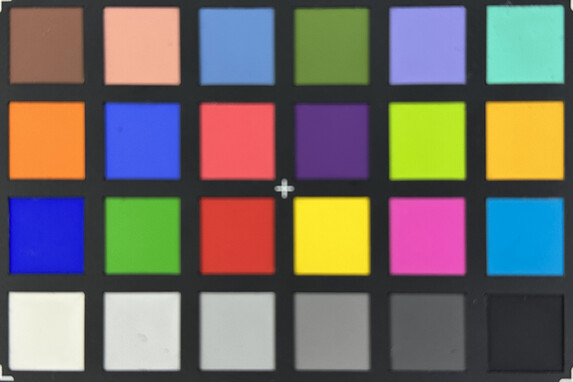
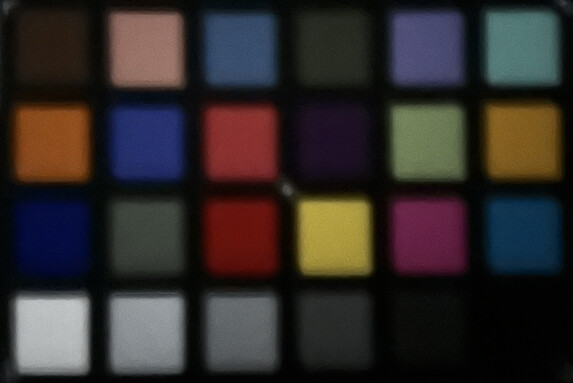
Accessories and Warranty: Apple Care+ with unlimited repairs
The iPhone 14 Pro's scope of delivery is not exactly immense. Apple only includes a Lightning to USB type-C data/charging cable, SIM tool, Apple sticker, a quick-start guide, and warranty information.
Of course, Apple has numerous optional accessories on offer. This includes chargers, MagSafe products, cables, adapters, headphones, and a lot more.
The standard 12-month warranty applies in the US. More information can be found on our FAQ page. The optional Apple Care+ plan is once again available for a one-time fee that covers two years or for a monthly payment. While the second option is slightly more expensive, it allows for the coverage to exceed two years. The package is slightly more expensive overall, although there is no longer a limit on the number of accidental damage repairs per year.
Input devices & handling: Face ID included
The Apple iPhone 14 Pro comes with an excellent touchscreen that quickly and accurately responds to inputs. The haptics are good and the gliding properties warrant no criticism. Apple continues to use its own keyboard layout with numerous features that now include simultaneous voice inputs while typing. Additionally, haptic feedback for the keyboard is now available.
The 3D facial recognition solution Face ID can be used to secure the device biometrically, and it recognizes the user even when using a mask. Although this requires the user to look down and takes slightly longer, it still works quite well.
The one-handed mode is already enabled by default and available by swiping down on the bottom edge of the screen. Tapping on the back is once again recognized and differentiates between double and triple taps, which can be set to different actions via the settings.
Display: iPhone 14 Pro with stupendously bright 120 Hz OLED
The so-called Super Retina XDR OLED display of the Apple iPhone 14 Pro measures 6.1 inches (15.49 cm) diagonally, has a resolution of 2556 x 1179 pixels, and automatically adjusts its refresh rate between 1 Hz and 120 Hz.
While the brightness of 1,000 nits matches that of its predecessor, Apple has significantly boosted the peak brightness, which it claims can reach up to 2000 nits. We measured an even higher value of 2294 nits (APL18), representing the absolute highest value we have seen so far.
The ambient light sensor has to be enabled in order to attain such high brightness levels. When the brightness is controlled manually, the luminance maxes out at 845 nits. Due to the underlying OLED technology and the resulting absolute black value, the panel's contrast ratio theoretically approaches infinity.
Even an iPhone is not immune to OLED flickering. Our oscilloscope reveals fairly calm cycling at a constant 240 Hz at minimum brightness and a frequency of a steady 480 Hz at above 39 % brightness, which is comparable to high-frequency DC dimming. This should reduce eyestrain for sensitive users. We did not observe temporal dithering. In order to test this, we looked at the display with a microscope and playing a 240 fps slow motion video (dark gray, maximum brightness).
| |||||||||||||||||||||||||
Brightness Distribution: 98 %
Center on Battery: 1046 cd/m²
Contrast: ∞:1 (Black: 0 cd/m²)
ΔE ColorChecker Calman: 1.2 | ∀{0.5-29.43 Ø4.77}
ΔE Greyscale Calman: 1.7 | ∀{0.09-98 Ø5}
99.8% sRGB (Calman 2D)
Gamma: 2.19
CCT: 6538 K
| Apple iPhone 14 Pro Super Retina XDR OLED, 2556x1179, 6.1" | Samsung Galaxy S22 Ultra 5G Dynamic AMOLED, 3088x1440, 6.8" | Oppo Find X5 Pro AMOLED, 3216x1440, 6.7" | Motorola Edge 30 Ultra pOLED, 2400x1080, 6.7" | Xiaomi 12S Ultra OLED, 3200x1440, 6.7" | Sony Xperia 1 IV OLED, 3840x1644, 6.5" | Honor Magic4 Pro OLED, 2848x1312, 6.8" | Vivo X80 Pro AMOLED, 3200x1440, 6.8" | Apple iPhone 13 Pro OLED, 2532x1170, 6.1" | |
|---|---|---|---|---|---|---|---|---|---|
| Screen | 11% | 3% | -1% | -7% | 6% | -47% | 11% | 9% | |
| Brightness middle (cd/m²) | 1046 | 1077 3% | 746 -29% | 1020 -2% | 831 -21% | 890 -15% | 956 -9% | 938 -10% | 1050 0% |
| Brightness (cd/m²) | 1049 | 1093 4% | 744 -29% | 1020 -3% | 807 -23% | 897 -14% | 959 -9% | 947 -10% | 1058 1% |
| Brightness Distribution (%) | 98 | 97 -1% | 97 -1% | 96 -2% | 91 -7% | 97 -1% | 94 -4% | 97 -1% | 98 0% |
| Black Level * (cd/m²) | |||||||||
| Colorchecker dE 2000 * | 1.2 | 1.2 -0% | 0.9 25% | 1 17% | 1.03 14% | 0.9 25% | 2.4 -100% | 0.9 25% | 1 17% |
| Colorchecker dE 2000 max. * | 3.1 | 2 35% | 1.6 48% | 2.8 10% | 3.06 1% | 2.4 23% | 5.2 -68% | 1.9 39% | 2.4 23% |
| Greyscale dE 2000 * | 1.7 | 1.3 24% | 1.6 6% | 2.1 -24% | 1.8 -6% | 1.4 18% | 3.3 -94% | 1.3 24% | 1.5 12% |
| Gamma | 2.19 100% | 2.37 93% | 2.23 99% | 2.29 96% | 2.233 99% | 2.21 100% | 2.26 97% | 2.2 100% | 2.2 100% |
| CCT | 6538 99% | 6526 100% | 6499 100% | 6502 100% | 6396 102% | 6320 103% | 6804 96% | 6518 100% | 6504 100% |
* ... smaller is better
Screen Flickering / PWM (Pulse-Width Modulation)
| Screen flickering / PWM detected | 240 Hz | ||
The display backlight flickers at 240 Hz (worst case, e.g., utilizing PWM) . The frequency of 240 Hz is relatively low, so sensitive users will likely notice flickering and experience eyestrain at the stated brightness setting and below. In comparison: 53 % of all tested devices do not use PWM to dim the display. If PWM was detected, an average of 8084 (minimum: 5 - maximum: 343500) Hz was measured. | |||
Measured at a fixed zoom level at various brightness settings
We assess the color accuracy of the iPhone 14 Pro's display with the help of a spectrophotometer and the CalMAN analysis software. Our findings show better color accuracy with the True Tone disabled. This mode adjusts the color balance of the display depending on the ambient lighting conditions. This generally results in a warmer color balance, which increases in intensity as the daylight disappears. Regardless, the display is subjectively easier on the eyes with True Tone enabled. Both modes offer high color accuracy.
Display Response Times
| ↔ Response Time Black to White | ||
|---|---|---|
| 0.81 ms ... rise ↗ and fall ↘ combined | ↗ 0.409 ms rise | |
| ↘ 0.401 ms fall | ||
| The screen shows very fast response rates in our tests and should be very well suited for fast-paced gaming. In comparison, all tested devices range from 0.1 (minimum) to 240 (maximum) ms. » 2 % of all devices are better. This means that the measured response time is better than the average of all tested devices (20.2 ms). | ||
| ↔ Response Time 50% Grey to 80% Grey | ||
| 1.81 ms ... rise ↗ and fall ↘ combined | ↗ 0.9645 ms rise | |
| ↘ 0.844 ms fall | ||
| The screen shows very fast response rates in our tests and should be very well suited for fast-paced gaming. In comparison, all tested devices range from 0.165 (minimum) to 636 (maximum) ms. » 8 % of all devices are better. This means that the measured response time is better than the average of all tested devices (31.6 ms). | ||
The iPhone 14 Pro appears to be very well suited for outdoor use. The ambient light sensor quickly responds to changing conditions and is not stingy with its luminance under bright sunlight. With more than 2200 nits, Apple's latest smartphone remains readable in all situations.
Performance: iPhone 14 Pro with A16 Bionic
This year's iPhone 14 Pro once again uses a new SoC from the manufacturer itself, the Apple A16 Bionic, which is exclusive to the Pro models this time. The chip uses a CPU with six cores, two of which are performance and four of which are efficiency cores. The fast cores now have an even higher clock speed of up to 3.46 GHz. The transistor count has grown slightly as well.
The iPhone 14 Pro's single and multi-core performance is 7 and 15 % higher, respectively, according to Geekbench and at a level that is far above that of Android competitors with the Snapdragon 8+ Gen 1.
The system benchmark results are not quite as impressive with Qualcomm SoC competitors performing better in AnTuTu while once again falling behind compared to the Apple smartphone in CrossMark. Although the NPU acceleration is also excellent in our comparison, the AIMark scores are significantly worse compared to last year's model. This matches our observation of many Snapdragon devices in this particular benchmark. The Geekbench ML scores appear to be more meaningful for comparison purposes and show the A16 to be very far ahead at times.
The storage performance of the iPhone matches its predecessor, although the 128 GB model performs worse, which may have a similar cause as on the MacBook Air, where the individual storage blocks have become larger and a single 128 GB storage chip is slower than a smartphone with two storage chips working in parallel. This does not noticeably impact daily use, however.
The Apple A16 GPU once again consists of five cores that are supposed to be about 19 % faster thanks to the wider memory bus of the 6 GB of LPDDR5 RAM. We only see glimpses of this in certain GFXBenchmark scenarios with the GPU usually falling below this value. Regardless, it is blazing fast and able to leave the Adreno 730 in the dust, particularly when using software made for the Metal API. The Qualcomm GPU (Vulkan API) is nonetheless able to go head-to-head in the brand-new 4K Aztec Ruins High Tier GFXBench scenario, while not being too far off in the Basemark GPUScore.
GFXBench (DX / GLBenchmark) 2.7: T-Rex Onscreen | 1920x1080 T-Rex Offscreen
GFXBench 3.0: on screen Manhattan Onscreen OGL | 1920x1080 1080p Manhattan Offscreen
GFXBench 3.1: on screen Manhattan ES 3.1 Onscreen | 1920x1080 Manhattan ES 3.1 Offscreen
GFXBench: on screen Car Chase Onscreen | 1920x1080 Car Chase Offscreen | on screen Aztec Ruins High Tier Onscreen | 2560x1440 Aztec Ruins High Tier Offscreen | on screen Aztec Ruins Normal Tier Onscreen | 1920x1080 Aztec Ruins Normal Tier Offscreen | 3840x2160 4K Aztec Ruins High Tier Offscreen
| 3DMark / Wild Life Extreme | |
| Apple iPhone 14 Pro | |
| Apple iPhone 13 Pro | |
| Xiaomi 12S Ultra | |
| Motorola Edge 30 Ultra | |
| Honor Magic4 Pro | |
| Oppo Find X5 Pro | |
| Vivo X80 Pro | |
| Sony Xperia 1 IV | |
| Samsung Galaxy S22 Ultra 5G | |
| 3DMark / Wild Life Unlimited Score | |
| Apple iPhone 14 Pro | |
| Apple iPhone 13 Pro | |
| Xiaomi 12S Ultra | |
| Motorola Edge 30 Ultra | |
| Honor Magic4 Pro | |
| Oppo Find X5 Pro | |
| Vivo X80 Pro | |
| Sony Xperia 1 IV | |
| Samsung Galaxy S22 Ultra 5G | |
| 3DMark / Wild Life Score | |
| Oppo Find X5 Pro | |
| Apple iPhone 13 Pro | |
| Sony Xperia 1 IV | |
| Samsung Galaxy S22 Ultra 5G | |
| Honor Magic4 Pro | |
| Vivo X80 Pro | |
| GFXBench (DX / GLBenchmark) 2.7 / T-Rex Onscreen | |
| Motorola Edge 30 Ultra | |
| Honor Magic4 Pro | |
| Xiaomi 12S Ultra | |
| Samsung Galaxy S22 Ultra 5G | |
| Sony Xperia 1 IV | |
| Apple iPhone 13 Pro | |
| Oppo Find X5 Pro | |
| Vivo X80 Pro | |
| Apple iPhone 14 Pro | |
| GFXBench (DX / GLBenchmark) 2.7 / T-Rex Offscreen | |
| Apple iPhone 14 Pro | |
| Motorola Edge 30 Ultra | |
| Xiaomi 12S Ultra | |
| Honor Magic4 Pro | |
| Apple iPhone 13 Pro | |
| Oppo Find X5 Pro | |
| Sony Xperia 1 IV | |
| Samsung Galaxy S22 Ultra 5G | |
| Vivo X80 Pro | |
| GFXBench 3.0 / 1080p Manhattan Offscreen | |
| Apple iPhone 14 Pro | |
| Xiaomi 12S Ultra | |
| Motorola Edge 30 Ultra | |
| Apple iPhone 13 Pro | |
| Samsung Galaxy S22 Ultra 5G | |
| Honor Magic4 Pro | |
| Oppo Find X5 Pro | |
| Sony Xperia 1 IV | |
| Vivo X80 Pro | |
| GFXBench 3.1 / Manhattan ES 3.1 Onscreen | |
| Motorola Edge 30 Ultra | |
| Honor Magic4 Pro | |
| Xiaomi 12S Ultra | |
| Samsung Galaxy S22 Ultra 5G | |
| Apple iPhone 13 Pro | |
| Sony Xperia 1 IV | |
| Vivo X80 Pro | |
| Apple iPhone 14 Pro | |
| Oppo Find X5 Pro | |
| GFXBench 3.1 / Manhattan ES 3.1 Offscreen | |
| Apple iPhone 14 Pro | |
| Xiaomi 12S Ultra | |
| Motorola Edge 30 Ultra | |
| Apple iPhone 13 Pro | |
| Honor Magic4 Pro | |
| Samsung Galaxy S22 Ultra 5G | |
| Sony Xperia 1 IV | |
| Oppo Find X5 Pro | |
| Vivo X80 Pro | |
| GFXBench / Car Chase Onscreen | |
| Motorola Edge 30 Ultra | |
| Xiaomi 12S Ultra | |
| Apple iPhone 13 Pro | |
| Apple iPhone 14 Pro | |
| Honor Magic4 Pro | |
| Vivo X80 Pro | |
| Sony Xperia 1 IV | |
| Samsung Galaxy S22 Ultra 5G | |
| Oppo Find X5 Pro | |
| GFXBench / Car Chase Offscreen | |
| Apple iPhone 14 Pro | |
| Motorola Edge 30 Ultra | |
| Xiaomi 12S Ultra | |
| Honor Magic4 Pro | |
| Apple iPhone 13 Pro | |
| Samsung Galaxy S22 Ultra 5G | |
| Sony Xperia 1 IV | |
| Oppo Find X5 Pro | |
| Vivo X80 Pro | |
| GFXBench / Aztec Ruins High Tier Onscreen | |
| Motorola Edge 30 Ultra | |
| Xiaomi 12S Ultra | |
| Apple iPhone 13 Pro | |
| Apple iPhone 14 Pro | |
| Vivo X80 Pro | |
| Sony Xperia 1 IV | |
| Honor Magic4 Pro | |
| Oppo Find X5 Pro | |
| Samsung Galaxy S22 Ultra 5G | |
| GFXBench / Aztec Ruins High Tier Offscreen | |
| Motorola Edge 30 Ultra | |
| Honor Magic4 Pro | |
| Xiaomi 12S Ultra | |
| Apple iPhone 14 Pro | |
| Oppo Find X5 Pro | |
| Apple iPhone 13 Pro | |
| Vivo X80 Pro | |
| Samsung Galaxy S22 Ultra 5G | |
| Sony Xperia 1 IV | |
| GFXBench / Aztec Ruins Normal Tier Onscreen | |
| Motorola Edge 30 Ultra | |
| Xiaomi 12S Ultra | |
| Honor Magic4 Pro | |
| Apple iPhone 13 Pro | |
| Vivo X80 Pro | |
| Apple iPhone 14 Pro | |
| Sony Xperia 1 IV | |
| Oppo Find X5 Pro | |
| Samsung Galaxy S22 Ultra 5G | |
| GFXBench / Aztec Ruins Normal Tier Offscreen | |
| Apple iPhone 14 Pro | |
| Apple iPhone 13 Pro | |
| Motorola Edge 30 Ultra | |
| Xiaomi 12S Ultra | |
| Honor Magic4 Pro | |
| Oppo Find X5 Pro | |
| Vivo X80 Pro | |
| Sony Xperia 1 IV | |
| Samsung Galaxy S22 Ultra 5G | |
| GFXBench / 4K Aztec Ruins High Tier Offscreen | |
| Motorola Edge 30 Ultra | |
| Apple iPhone 14 Pro | |
| Honor Magic4 Pro | |
| Xiaomi 12S Ultra | |
| Vivo X80 Pro | |
| Sony Xperia 1 IV | |
Basemark GPU score
The iPhone 14 Pro shines in our browser benchmarks and pulls far ahead of all Android competitors. Browsing the web during day-to-day use feels very smooth and comfortable. The subjective differences are smaller than the benchmarks suggest, however.
| Jetstream 2 - 2.0 Total Score | |
| Apple iPhone 14 Pro (Safari 16) | |
| Apple iPhone 13 Pro (Safari 15) | |
| Average of class Smartphone (23.8 - 387, n=147, last 2 years) | |
| Sony Xperia 1 IV (Chrome 103) | |
| Motorola Edge 30 Ultra (Chrome 105) | |
| Xiaomi 12S Ultra (Chrome 104) | |
| Oppo Find X5 Pro (Chrome 99) | |
| Samsung Galaxy S22 Ultra 5G (Chrome 99) | |
| Honor Magic4 Pro (Chrome 102) | |
| Vivo X80 Pro | |
| Speedometer 2.0 - Result 2.0 | |
| Apple iPhone 14 Pro (Safari 16) | |
| Apple iPhone 13 Pro (Safari 15) | |
| Average of class Smartphone (15.2 - 643, n=119, last 2 years) | |
| Sony Xperia 1 IV (Chrome 103) | |
| Samsung Galaxy S22 Ultra 5G (Chrome 99) | |
| Oppo Find X5 Pro (Chrome 99) | |
| Motorola Edge 30 Ultra (Chrome 105) | |
| Vivo X80 Pro (Chrome 103) | |
| Xiaomi 12S Ultra (Chrome 104) | |
| Honor Magic4 Pro (Chrome 102) | |
| WebXPRT 4 - Overall | |
| Apple iPhone 14 Pro (Safari 16) | |
| Average of class Smartphone (27 - 306, n=143, last 2 years) | |
| Sony Xperia 1 IV (Chrome 103) | |
| Xiaomi 12S Ultra (Chrome 104) | |
| Motorola Edge 30 Ultra (Chrome 105) | |
| Honor Magic4 Pro (Chrome 102) | |
| WebXPRT 3 - Overall | |
| Apple iPhone 14 Pro (Safari 16) | |
| Apple iPhone 13 Pro (Safari 15) | |
| Average of class Smartphone (38 - 380, n=30, last 2 years) | |
| Sony Xperia 1 IV (Chrome 103) | |
| Motorola Edge 30 Ultra (Chrome 105) | |
| Xiaomi 12S Ultra (Chrome 104) | |
| Oppo Find X5 Pro (Chrome 99) | |
| Samsung Galaxy S22 Ultra 5G (Chrome 99) | |
| Honor Magic4 Pro (Chrome 102) | |
| Vivo X80 Pro (Chrome 103) | |
| Octane V2 - Total Score | |
| Apple iPhone 14 Pro (Safari 16) | |
| Apple iPhone 13 Pro (Safari 15) | |
| Average of class Smartphone (2228 - 126661, n=194, last 2 years) | |
| Sony Xperia 1 IV (Chrome 103) | |
| Vivo X80 Pro (Chrome 103) | |
| Oppo Find X5 Pro (Chrome 99) | |
| Motorola Edge 30 Ultra (Chrome 105) | |
| Xiaomi 12S Ultra (Chrome 104) | |
| Samsung Galaxy S22 Ultra 5G (Chrome 99) | |
| Honor Magic4 Pro (Chrome 102) | |
| Mozilla Kraken 1.1 - Total | |
| Honor Magic4 Pro (Chrome 102) | |
| Samsung Galaxy S22 Ultra 5G (Chrome 99) | |
| Vivo X80 Pro (Chrome 103) | |
| Average of class Smartphone (257 - 28190, n=154, last 2 years) | |
| Oppo Find X5 Pro (Chrome 99) | |
| Motorola Edge 30 Ultra (Chrome 105) | |
| Xiaomi 12S Ultra (Chrome 104) | |
| Sony Xperia 1 IV (Chrome 103) | |
| Apple iPhone 14 Pro (Safari 16) | |
| Apple iPhone 13 Pro (Safari 15) | |
* ... smaller is better
Gaming: iPhone with lots of gaming power
The iPhone 14 Pro is an outstanding gaming smartphone on paper. This includes the extremely high performance of the A16 GPU, the fast 120 Hz display, and even the stereo speakers. Although the Dynamic Island is somewhat distracting in certain games, since it obstructs a part of the screen, this is not a major issue.
This is where we would normally present you with a detailed analysis of various games courtesy of our partner GameBench, but unfortunately the software is not yet compatible with the latest iOS version. We will append the benchmarks and analysis as soon as possible.
Emissions: Barely higher than an iPhone 13 under load
Temperature
The surface temperatures of the Apple iPhone 14 Pro are very low during idle and barely scratch the 29-degree mark. Although, unsurprisingly, this changes under load wherein the device only becomes lukewarm to the touch.
On the inside, this Californian smartphone does break a sweat and the A16 SoC has to reduce its performance under prolonged 3DMark stress. While the performance dip is less significant compared to many Android competitors, which results in the smartphone rendering around 12 more frames per second than the Edge 30 Ultra, it only beats the iPhone 13 Pro by one fps.
This is where the benefits of a gaming smartphone become apparent, such as the ROG Phone 6 Pro shows with its 11 more fps in the Wild Life stress test in fanless mode compared to the Apple phone. Overall, all competitors deliver sufficient performance for a consistently smooth experience.
Although the differences in the demanding extreme test are smaller, the frame rates are too low for smooth visuals even at the beginning of the test
(+) The maximum temperature on the upper side is 37.6 °C / 100 F, compared to the average of 35.2 °C / 95 F, ranging from 21.9 to 247 °C for the class Smartphone.
(+) The bottom heats up to a maximum of 37.9 °C / 100 F, compared to the average of 34 °C / 93 F
(+) In idle usage, the average temperature for the upper side is 28 °C / 82 F, compared to the device average of 32.9 °C / 91 F.
3DMark Wild Life Stress Test
Speakers
The two speakers of the iPhone 14 Pro produce a fairly balanced sound with distinct lower mids but still without proper depth and bass, which becomes more apparent as the volume increases.
Users who wish to use wired headphones will have to either own a pair of Lightning headphones or use a USB type-C or 3.5 mm adapter. The aforementioned 3.5 mm adapter is available from Apple as an optional accessory for US$9 and includes a D/A converter, enabling the connected headphones to receive lossless audio. Although only SBC and AAC audio codecs are supported via Bluetooth, Dolby Atmos and 3D Audio are also available. Audiophiles will quickly run into limitations since high-res codecs such as aptX LL or LDAC are not supported.
Apple iPhone 14 Pro audio analysis
(+) | speakers can play relatively loud (89.5 dB)
Bass 100 - 315 Hz
(-) | nearly no bass - on average 20.3% lower than median
(±) | linearity of bass is average (8.3% delta to prev. frequency)
Mids 400 - 2000 Hz
(+) | balanced mids - only 4.9% away from median
(+) | mids are linear (4.9% delta to prev. frequency)
Highs 2 - 16 kHz
(±) | higher highs - on average 8.2% higher than median
(+) | highs are linear (2.6% delta to prev. frequency)
Overall 100 - 16.000 Hz
(±) | linearity of overall sound is average (17.5% difference to median)
Compared to same class
» 12% of all tested devices in this class were better, 9% similar, 79% worse
» The best had a delta of 11%, average was 35%, worst was 134%
Compared to all devices tested
» 33% of all tested devices were better, 8% similar, 59% worse
» The best had a delta of 4%, average was 24%, worst was 134%
Samsung Galaxy S22 Ultra 5G audio analysis
(+) | speakers can play relatively loud (90.2 dB)
Bass 100 - 315 Hz
(-) | nearly no bass - on average 24.4% lower than median
(±) | linearity of bass is average (8.8% delta to prev. frequency)
Mids 400 - 2000 Hz
(±) | higher mids - on average 6.3% higher than median
(+) | mids are linear (4.8% delta to prev. frequency)
Highs 2 - 16 kHz
(±) | higher highs - on average 5.6% higher than median
(+) | highs are linear (4.1% delta to prev. frequency)
Overall 100 - 16.000 Hz
(±) | linearity of overall sound is average (18.5% difference to median)
Compared to same class
» 20% of all tested devices in this class were better, 9% similar, 71% worse
» The best had a delta of 11%, average was 35%, worst was 134%
Compared to all devices tested
» 41% of all tested devices were better, 8% similar, 52% worse
» The best had a delta of 4%, average was 24%, worst was 134%
Power management: iPhone 14 Pro with a 3200-mAh battery
Energy consumption
The power draw of the Apple iPhone 14 Pro is exemplary and significantly lower compared to the Android competition in scenarios with a fixed brightness level. While this also applies to the previous model in Geekbench and GFXBench, the iPhone 13 Pro is more economical while idling.
A charger is not included. In order to charge the smartphone as quickly as possible, Apple recommends a charger rated at least 20 W that should then allow charging the battery to 50 % within half an hour. These are not exactly record-breaking speeds. For comparison, the Motorola Edge 30 Ultra is able to fully recharge its battery (4,610 mAh) twice within the same time period using the included 125 W charger.
Alternatively, the Apple smartphone can be charged at 15 W on a MagSafe charging station or at 7.5 W on a Qi-compatible charging plate.
| Off / Standby | |
| Idle | |
| Load |
|
Key:
min: | |
| Apple iPhone 14 Pro 3200 mAh | Samsung Galaxy S22 Ultra 5G 5000 mAh | Oppo Find X5 Pro 5000 mAh | Motorola Edge 30 Ultra 4610 mAh | Xiaomi 12S Ultra 4860 mAh | Sony Xperia 1 IV 5000 mAh | Honor Magic4 Pro 4600 mAh | Vivo X80 Pro 4700 mAh | Average Apple A16 Bionic | Average of class Smartphone | |
|---|---|---|---|---|---|---|---|---|---|---|
| Power Consumption | -30% | -31% | -12% | -9% | -51% | -48% | -48% | -74% | -56% | |
| Idle Minimum * (Watt) | 0.56 | 0.58 -4% | 1.24 -121% | 0.74 -32% | 0.9 -61% | 1.06 -89% | 0.87 -55% | 0.92 -64% | 0.842 ? -50% | 0.847 ? -51% |
| Idle Average * (Watt) | 1.37 | 0.71 48% | 1.39 -1% | 1.84 -34% | 1 27% | 1.71 -25% | 2.04 -49% | 2.04 -49% | 2.66 ? -94% | 1.448 ? -6% |
| Idle Maximum * (Watt) | 1.42 | 1.16 18% | 1.42 -0% | 1.86 -31% | 1.2 15% | 1.89 -33% | 2.26 -59% | 2.05 -44% | 2.71 ? -91% | 1.633 ? -15% |
| Load Average * (Watt) | 3.42 | 7.07 -107% | 3.58 -5% | 2.75 20% | 3.5 -2% | 4.99 -46% | 4.97 -45% | 4.29 -25% | 5.76 ? -68% | 6.96 ? -104% |
| Load Maximum * (Watt) | 5.56 | 11.32 -104% | 6.99 -26% | 4.54 18% | 6.9 -24% | 8.91 -60% | 7.46 -34% | 8.75 -57% | 9.28 ? -67% | 11.3 ? -103% |
* ... smaller is better
Consumption: Geekbench (150 nits)
Consumption: GFXBench (150 nits)
Battery life
Although the battery life of the iPhone 14 Pro is excellent, it is shorter than that of the iPhone 13 Pro even though we measured a lower consumption on the newer model. In our real-world Wi-Fi test at a fixed display brightness (150 nits), this can be explained with an increased power draw from the communications modules.
However, the results of our infinite video loop test with the short film Big Buck Bunny, which is performed offline, are more difficult to explain. Apple may still tweak a few parameters in future software updates. Regardless, the iPhone 14 Pro's battery should easily last for an entire day even with intensive use.
| Apple iPhone 14 Pro 3200 mAh | Samsung Galaxy S22 Ultra 5G 5000 mAh | Oppo Find X5 Pro 5000 mAh | Motorola Edge 30 Ultra 4610 mAh | Xiaomi 12S Ultra 4860 mAh | Sony Xperia 1 IV 5000 mAh | Honor Magic4 Pro 4600 mAh | Vivo X80 Pro 4700 mAh | Apple iPhone 13 Pro 3095 mAh | |
|---|---|---|---|---|---|---|---|---|---|
| Battery runtime | -8% | -18% | -8% | -11% | -45% | -21% | -22% | 6% | |
| Reader / Idle (h) | 44.3 | 32.9 -26% | 21.2 -52% | 36.8 -17% | 29.4 -34% | 16.3 -63% | 22.4 -49% | 28.8 -35% | 43.6 -2% |
| H.264 (h) | 23.3 | 18 -23% | 19 -18% | 19.8 -15% | 18.5 -21% | 10.6 -55% | 16.6 -29% | 15.7 -33% | 24.9 7% |
| WiFi v1.3 (h) | 13.5 | 14.1 4% | 13.1 -3% | 14.5 7% | 15.9 18% | 7.1 -47% | 11.5 -15% | 14.2 5% | 16.6 23% |
| Load (h) | 5.9 | 6.8 15% | 6.1 3% | 5.4 -8% | 5.5 -7% | 5 -15% | 6.5 10% | 4.5 -24% | 5.6 -5% |
Pros
Cons
Verdict: Successful upgrade with marketing finesse
The Apple iPhone 14 Pro is a step in the right direction within its own small evolution. The new A16 processor once again provides a performance boost over its predecessor, but the difference is nothing major. In terms of sustained performance, it is barely faster than its predecessor in the iPhone 13 Pro. The often-criticized and frequently copied notch has been replaced by a dual hole-punch solution, which Apple has creatively transformed into an island via software thus breathing new life into a tried and tested technology.
Similarly, the new camera sensor has 48 megapixels, uses pixel-binning and has been mass-distributed by Sony in the Android sector since 2018. Although this does not technically make it a major new feature, Apple has managed to integrate the component into the iPhone ecosystem well enough for it to feel like it should have always been there. The image quality is good and the Californians did not overpromise by saying that the 2x digital zoom is good enough to warrant a dedicated button.
The iPhone 14 Pro is a well-made smartphone that fits well into its tailor-made ecosystem and leaves few points of attack for the competition.
In terms of technology, Apple gets almost everything right — the slightly subpar Wi-Fi transfer rates being one of the very few weak points. However, it is questionable whether this will have any impact on day-to-day use. Meanwhile, the 6 GHz Wi-Fi band is still not supported. While we can forgive the lack of mmWave 5G on the iPhone 14 Pro on the European models, we would have been pleased to see the feature already included due to the long lifespan of the device. Similarly, the limited Bluetooth audio codec support continues to be an annoyance.
If you choose an iPhone, you most likely will not regret it. That being said, we found no real reason to upgrade from an iPhone 12 Pro or a 13 Pro to the new model. If you want more screen space and longer battery life, the iPhone 14 Pro Max sister model may be worth considering.
If you do not feel at home within the Apple cosmos, have a hard time navigating it, miss features, or simply want to spend less, strong competitors from the Android sector such as the Samsung Galaxy S22 Ultra, Google Pixel 6 Pro, Motorola Edge 30 Ultra, or the Honor Magic4 Pro can be good alternatives.
Price and Availability
Apple iPhone 14 Pro
- 09/30/2022 v7 (old)
Daniel Schmidt




